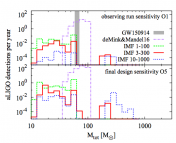
Today’s guest post was written by Miguel Martinez, a recent graduate from Columbia University taking a gap year with the Rasio group at CIERA at Northwestern University. In his free time, he enjoys films, video games, and martial arts. He would also like to note that he has since cut his hair.
Authors: C. L. Rodriguez, M. Zevin, P. Amaro-Seoane, S. Chatterjee, K. Kremer, F. Rasio, C. S. Ye
First Author’s Institution: Harvard (then MIT)
Status: Published in APS Phys Rev D, open access on arXiv
LIGO has been up and running for a few years now, and with O3 (the third observation run) currently underway, a lot of debate still happens in the literature about the nature of LIGO sources. In general relativity, black holes are fully described using only three numbers: the charge, mass, and spin. In almost all cases, we assume that astrophysical black holes have negligible charges. However, the mass and spin of black holes can have a range of different values, and the distribution of these values in the LIGO sources we see can tell us the origin of the sources.
One explanation of how to get two black holes to merge contends that a binary star system coevolved through the main sequence, eventually becoming a black hole binary. On the other hand, this study continues a line of inquiry into what is sometimes called the dynamical channel of black hole mergers. In the extremely dense environment of star clusters, when you get a lot of things bouncing around in a small volume, you’re bound to form at least a few binaries. As a result, the binaries will look very different than those formed through normal stellar evolution. Today’s paper focuses in particular on the dynamics within globular clusters, extremely old spherical clusters of 104 to 106 stars.
The extra sauce in this study is acknowledging the distinction between first and second generation (1G and 2G) black holes. 1G black holes form normally through stellar evolution off the Main Sequence. Eventually, a couple of these 1G black holes will merge to form a 2G black hole. So why does this matter? It’s commonly thought that the compact object initial mass function has a mass gap that occurs between about 50-130 M☉ (solar masses) due to mass loss from pulsational pair instability in massive stars. Even if you believe that this is true, nothing prevents two black holes merging into a 70 M☉ black hole. So, if LIGO detects a high mass component in a binary within this higher mass gap, we know they were dynamically formed.
However, there is no reason to assume all 2G objects will remain in the cluster. When two black holes merge, the newly formed black hole will be shot off in some direction in order to conserve momentum. If this natal kick is greater than the local escape speed, the merger remnant will escape the cluster, never to merge again. Additionally, normal 3- and 4-body interactions can potentially kick out some of these black holes. The authors deal with these complications agnostically by simulating the evolution of 96 different models of globular clusters. From these simulations, they can see how many mergers happen and see how many of these merger remnants remain in the cluster. As it turns out, the mergers with at least one 2G black hole comprise a small but not insignificant fraction of the total mergers. Furthermore, since larger mergers are easier to detect and 2G BHs are larger than 1G BHs, these 1G+2G and 2G+2G mergers will make up an even larger fraction of the detected mergers from the dynamical channel.
There is one more part of the story that we’ve neglected so far: the spin distribution of the black holes. Before that, one caveat: what LIGO measures is not the actual spin of the merger remnant, but the effective spin of the binary (known as χeff), a quantity that measures the orientation of the combined spin of the system with the orbit itself. In clusters, binaries form and break up like Legos, the spins will be usually misaligned and therefore close to 0. Since 2G black holes are always born with a high spin AND are likely more massive, they contribute more spin to the merger, it’s also more likely to detect a merger with a higher spin. While a single detection can’t tell us much, a large number of detections gives us a distribution which can be compared to the models such as the ones produced by the authors in Figure 2.
So in the end, what does this all mean? Basically, we have two ways of confirming the validity of the dynamical channel. If we see a binary with at least one component in the upper mass gap, i.e. a merger where at least one component is greater than 50 M☉, that’s a dead giveaway that it is the product of a previous merger. If not, at the very least we’ll be able to tell by looking at the distribution of spins as more data comes in. It is also possible that we’ve already confirmed this channel. In April 2019 a team at the Institute for Advanced Studies at Princeton did their own analysis of the LIGO data and found an additional seven faint merger signals, some of which tantalizingly hint at dynamical origins. Whether or not you trust that data, all eyes (ears?) are on LIGO as we wait to see what nature tells us.




